In Anaheim, a zoning change aims to inspire urban density
- Share via
The housing market is flat-lining, but that isn’t deterring Anaheim officials from changing zoning in the city’s sports district to permit nearly 20,000 new homes -- twice the number of condos, lofts and apartments already planned in the so-called Platinum Triangle.
The city wants to create a dense downtown near Angel Stadium and the Honda Center, an area now dominated by industrial facilities and office parks.
Despite the sour real estate market, city leaders say the demand for housing in Anaheim is there.
“These homes are not going to be built overnight,” said Councilman Bob Hernandez. “Like everything else, the housing market runs in cycles. It still doesn’t change the fact that we have more people who need homes than we can accommodate.”
Yet some developers in the Platinum Triangle have already decided to hold off building until the market improves. Lennar Corp. recently told the city it would slow construction on the centerpiece of the Platinum Triangle, A-Town -- planned to contain 2,700 condos, lofts and townhomes.
“The developers are kind of regrouping right now,” said Councilwoman Lucille Kring. “It can’t continue to slide. So let’s get all the infrastructure in place now. If you wait until the last minute when you really need more homes, you’re kind of scrambling.”
The City Council approved the zoning change at its meeting Tuesday night by a vote of 4 to 1, with Councilwoman Lorri Galloway dissenting.
The latest vision for the 820-acre Platinum Triangle comes just three years after the council rezoned a tired industrial district east of the Santa Ana Freeway in hopes of creating an urban village of high-rise buildings, lofts, shops and restaurants. More than a dozen residential projects have already been approved, and one, the Stadium Lofts condos, has been completed.
Anaheim officials increased the permitted number of homes in the district by allowing developers to build in areas formerly zoned for office towers and industrial space.
“If we don’t do this on a grand scale, what’s the use of doing it?” Hernandez said.
“I realize this kind of density is a foreign concept to a lot of people around here, but we’ve got to move beyond that. We’re no longer living in the 1950s in Anaheim. We have to establish new paradigms.”
Kring acknowledges that Anaheim’s plans for the Platinum Triangle are “very ambitious,” but said, “It’s not like 18,000 homes are going to be built overnight.”
Not everyone was upbeat about the zone change. Galloway said she was concerned that not enough low-cost housing was being built in the Platinum Triangle. So far, no projects there include homes for low-income families.
Most of the high-rise residential towers and mid-level townhomes and lofts in the Platinum Triangle will be linked by pedestrian-friendly avenues where residents and tourists can eat and shop or attend a ball game or hockey match at Angel Stadium or the Honda Center. City officials hope their emerging urban village can give suburban Orange County what it has lacked -- a downtown with a vibrant street scene.
“It won’t be a Chicago or New York, but it’ll almost be a city unto itself,” Kring said. “I see it as a high-energy, urbanized place. It will be very attractive to people who are tired of spending hours on the freeway and tired of caring for a yard.”
Hernandez said the Platinum Triangle’s key component would be the long-envisioned Anaheim Regional Transportation Intermodal Center, which will include the county’s largest bus terminal, platforms for Amtrak and Metrolink trains, and room to add tracks for the still-iffy high-speed rail.
“We’re trying to establish the first population center in Orange County that will be accommodated by mass transit,” Hernandez said. “All the growth in this county so far has been splintered, mostly because it lacks transit.”
Environmental studies pointed out that the Platinum Triangle’s increased density would create needs for an additional fire station, an electrical substation, a library and a water well.
More to Read
Sign up for Essential California
The most important California stories and recommendations in your inbox every morning.
You may occasionally receive promotional content from the Los Angeles Times.










